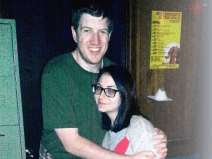The Challenge
Tim Liebrock’s freshman year of college at Syracuse University began just as he planned. He was making new friends and adjusting to college life without a hitch. He was even an avid boxer at a local gym, sparring as often as he could.
“I just really liked to get in the ring and go at it,” says Tim. “It was a great way to stay in shape and was so much fun at the same time.”
After wrapping up his first semester studying civil engineering, Tim headed back home to Pittsburgh to enjoy his holiday break. But, what should have been a relaxing month off from classes, tests, and studying, turned into something more stressful than he could have ever imagined.
“I was hanging out with some friends, just talking, when all of a sudden I dropped to the ground,” he says. “I don’t remember anything but I know I was unconscious and was jerking pretty violently. Luckily, my friends were there to help.”
Tim’s friends immediately called 911 and he was rushed to a local hospital. Doctors told Tim he suffered from a grand mal seizure, a type of seizure that is caused by abnormal electrical activity in the brain and causes a loss of consciousness and violent muscle contractions.
“Just knowing that the part of my brain responsible for my seizures was gone was a huge relief." — Tim
Often, a grand mal seizure is caused by epilepsy; however, many people who experience one never have a repeat incident. Because Tim had no previous symptoms of epilepsy, and his tests were normal, he was released.
But, the seizures didn’t stop.
“Only a short time after I had the first seizure, I was sitting in a restaurant eating lunch and just dropped,” says Tim. “That’s when I knew in my mind that I had epilepsy.”
A neurologist confirmed Tim’s self-diagnosis a short time later. To help control the seizures, he was put on anti-seizure medications. But even with the medications, he still continued to suffer.
“It was just getting really hard to deal with and was very stressful, especially being back at school full time," he says. “I knew that I needed some additional help. I couldn’t live the rest of my life this way, just waiting for the next seizure to happen.”
Schedule an Appointment or Ask a Question
The Solution
Tim was referred by his neurologist to a UPMC neurosurgeon and epilepsy expert. To determine if Tim was a candidate for epilepsy surgery, the medical team ran a series of tests to find the part of his brain responsible for the seizures.
Once the area was found, the team did extensive testing using state-of-the-art brain mapping imaging technology to determine any major problems with speaking, understanding, or other abilities that could arise if that area of the brain was removed.
Once the team confirmed that no impairments would be caused by removing the portion of the brain responsible for the seizures, Tim agreed to move forward with the surgery. “I knew this was the right thing to do, and I had total confidence that they could help get me back to normal,” he says.
During the procedure, surgeons removed a portion of Tim’s temporal lobe. And almost immediately after the surgery, Tim began to notice improvements.
The Results
I felt better pretty much instantly after the surgery,” he says. “Just knowing that the part of my brain responsible for my seizures was gone was a huge relief."
In the weeks and months that followed, Tim found that he was becoming his old self again. And most importantly, his seizures completely stopped.
Following graduation, Tim was hired as an engineer for a cell phone tower company. And although he can’t box anymore, Tim has few restrictions with what he’s able to do.
“Since the surgery, I’ve felt great and am able to do basically whatever I want, except for getting hit repeatedly in the head,” he says with a laugh. “The UPMC team basically got me to where I am today. I don’t think I could be working full time and leading my life the way I want to without them.”
Our patient stories profile a number of patients who have had minimally invasive brain surgery at UPMC. Although everyone's care experience is unique, we hope that sharing these stories will help other prospective patients and their families better understand these procedures and their potential benefits.
Tim's treatment and results may not be representative of all similar cases.

















